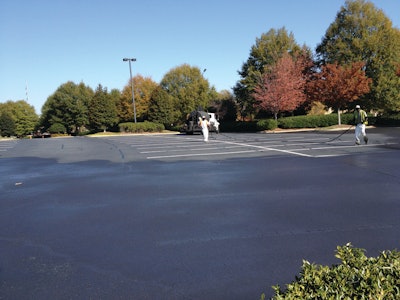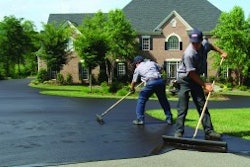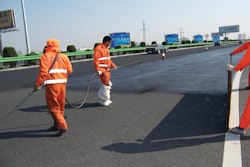
What do you do when you’re approached by a loyal customer, late in the season, to sealcoat a parking lot in a tight time frame under less-than-ideal conditions?
If you’re Asphalt Enterprises in Atlanta you put together a bid, hope to get the job, then get it done on time just like the other work you do. And that’s just what Gerry Signs, owner of the full-service pavement maintenance company, did near the end of last season.
“A long-time property manager customer at a very high-end office park complex, the Georgia 400 Center, contacted us and they needed the work done under a very tight deadline late in the season,” Signs says. “The Building Owners & Managers Association (BOMA) presents its Toby Awards each year and this customer wanted this property entered into the contest. They’d really been pushing all year to get the entire property ready to get this award and the parking lot work was the icing on the cake.”
Asphalt Enterprises, which celebrates its 30th anniversary this year, runs two sealcoating crews, one paving and patching crew, one concrete crew and one striping crew. They sub out milling and other site preparation work. Jared Marcom, vice president, helps manage the company which employs more than 25 people at peak season.
Signs says sales presentations are conducted using iPads, which enable a direct link to the contractor’s Walkie-Talkie designed website. “We use our website as a marketing tool because we can actually show projects, we can show how we completed the work, the tools and equipment we used and our crew on the job,” Signs says. “We think it’s very effective.”
But this late-season job didn’t require a sales pitch; it required an evaluation of the work to be done, the time frame, the weather conditions – and a waiving of the contractor’s policy not to sealcoat late in the season.
“Just two weeks earlier I happened to send out our newsletter explaining why we stop sealcoating when we do at the end of October,” Signs says. “I explained the whole thing so our customers were aware and so they understood that we do this in their best interest. But this was a loyal 15-year customer who needed our help.”
Signs says that normally Asphalt Enterprises can complete a job of this size – 70,000 sq. yds. of sealing with minimal pavement repairs and limited cracksealing – over two weekends when weather is warmer and days are longer. But because the job wasn’t let until late October, short work days, temperature and weather were concerns.
Through careful planning, communication with the property manager, flexible scheduling and proper use and application of the sealer Asphalt Enterprises was able to get the job done. “We finished on Nov. 11, which is about the very last day we ever want to be sealcoating,” Signs says.
Planning & Scheduling with Customer Input
Signs says planning this job, and every job of any size or complexity, is the most important part of the process. And planning involves a lot more than talking with the customer – although that’s the first step.
“If there’s one thing I think we do better than our competition it’s planning,” he says. “Every property is different so we like the property manager’s input on how to do the job, especially on apartments and shopping centers. We ask them if they have any special concerns, for example are they busy on certain days? Are there any events coming up we need to know about? Basically anything that will help us plan and organize the job because they know their property and their clients much better than we do.”
In this case Signs says the configuration of the parking lot had a lot to do with the final schedule. “There were a lot of cul-de-sacs and not as many drive lanes which we can do more quickly,” he says. “Sometimes we could only do half a cul-de-sac at a time because people needed to get in and out of the building, and that reduces our productivity.
“So we had to break it down,” he says. “We made arrangements with the property manager, and we were able to work on smaller sections on Monday, Tuesday and Friday even though the property was open and busy. The other sections we did on the weekends.”
Capabilities & Profitability
Once he has insight from the property manager he can begin to formulate a way to get the job done. He starts by factoring in the number of gallons of sealer his crews can apply in a day conveniently and to be profitable.
“You have to know the capabilities of your crew,” he says. “How many gallons can they put down in a day and is that enough for us to make a profit? Can they make the adjustments needed to get this job done in this time frame? Can they adapt to the schedule we need to put together to have us working in several locations? Luckily I know we have such great experienced manpower we can get a job like this done under the deadline and with all the time and temperature restrictions.
“Our production capabilities are based on past experience because we know how much we can put down in a day,” he says. “We are very willing to work with customers around their needs and schedule but we make sure the customer understands that we have to be profitable, too. That means we have to be able to get a certain amount of work done every day, every time we are out on the jobsite. We explained that we’re a business and we need to make money, which means we have to keep our production rate at a high level. At the same time we want to be sensitive to their needs and their concerns.”
Sealcoating on the job
The Asphalt Enterprises crew eventually got onto the property October 29 and completed all 365 sq. yds. of traditional remove-and-replace patching in one day using two Bobcat skid steers. The following week the crews sealed all 25,000 linear feet of cracks with two people blowing the cracks clean and three people following behind with walk-behind kettles.
“Here in Georgia you really don’t get the large cracks people get up north because winter is not as harsh,” Signs says. “We sub out cracksealing on really big jobs or if there are really deep cracks, but the small units are really good for the types of cracks we usually deal with.”
Signs says Asphalt Enterprises is GemSeal’s highest-volume applicator in the Atlanta area, applying both the federal spec GemSeal material and the higher-grade PolyTar. “Every job is a little different and when we bid jobs we like to give the customer alternatives,” Signs says. “We offer applications of two spray coats or one spray and one squeegee, and an upgrade option in sealer.” He says the two-coat squeegee/spray option has become more popular over the last five years because of the thicker coverage with squeegee over spray.
For this job Asphalt Enterprises’ crew applied 14,000 gallons of finished GemSeal federally specified material using a conventional two-spray coat system (first coat at .12 gal./sq. yd. ; second coat at .08/sq. yd.) to produce a nice cosmetic coating to brighten up the property. “It had been sealcoated before so a squeegee/spray approach really wasn‘t necessary.” Signs says. “We got really good coverage with two spray coats.”
One of the first decisions Signs made was to have supplier GemSeal drop a 4,000-gal. tank of uncut material at the jobsite (sand and latex were added into the sealcoating applicators on the site). “Anytime we can and where it makes sense we get a tanker dropped,” Signs says. “It’s a good idea on any job.”
Signs surveyed the parking lot looking to find “the most far-out place in the parking lot, away from everything and that hopefully would be the last area they sealcoated. Usually we just try to find an isolated place to drop the tank but also we need a place where we can have good and easy access to it so we don’t have to drive too far to get to it to refill tanks.”
Then once they started sealcoating crews arrived early to clean the pavement. “It’s a very high-profile property and the owners keep it swept clean. There was very little debris on it,” he says. “The only thing we really had to do because it was fall was to blow off the leaves.”
The crew used high-velocity walk-behind blowers each morning and used backpack blowers ahead of the sealcoating crew to keep leaves out of the way.
“We also worked with the property manager who had a good landscaping company and they arranged for the landscapers to get in before us to make it as free of leaves as possible. The property manager did everything in her power to help us get this job done by the deadline.”
Signs says the crews started sealcoating Saturday, Nov. 3. One office building was open that weekend, preventing Asphalt Enterprises from shutting down that lot. “So we did part of that lot and also a bigger open area across the street where we could shut the lot down completely.” To minimize unproductive time such as refilling the sealer equipment they decided to use the 1500-gal. unit on the larger lot and the 550-gal. machine on the smaller lot.
“We put the 1500-gal. unit on the larger lot because we knew we could finish that lot with that unit with no problems (without having to take the time to refill). “Then while waiting for the sealer to dry the 550 gallon unit came back to the drop tank to refill,” he says. “It worked out perfectly to refill between coats because we needed to let it cure anyway.”
“We don’t want to have to keep refilling the 550 so we match the size of the unit to its location,” Signs says. “We usually have two jobs going at the same time and we match the unit to the job. Here we did that within the job itself.”
Customer “rolls the dice”
Signs says that the way this job was scheduled meant a large amount of pavement had to be sealcoated on the second weekend. “Knowing we could get the big Saturday and Sunday sections done was important because any contractor can get the small areas done. It’s the large areas that can create a problem – especially late in the season.”
Signs says that because the job was done so late in the season crews had to start working later in the day to let the pavement warm up a bit. “We cleaned it each morning but didn’t even start edging until about 9:30. And we had to stop before dark.
“So we worked through the puzzle and figured out how we can get the work done at this time of year with six- or seven- hour work days as opposed to 10- or 12-hour days in the summer. Then we factor in the weather limitations. When you take on a project like this you have to know you can get it done under those conditions.”
But even with all this analysis and planning Asphalt Enterprises wanted the customer to know what might happen.
“I was having my doubts about getting the job done and we told our customer right up front that if we got past our cutoff date we could still finish the job but couldn’t warranty the sealer,” Signs says. “I let our customer roll the dice and she did and it worked out just great. The property manager is just tickled the way it turned out.”
END
[sidebar]
Clarity through Color-coded Maps
Based on discussions with clients and knowledge of his crews’ production capabilities Asphalt Enterprises creates color-coded property maps showing how the job will progress. “We’ve used them for 10-15 years but they’re easier now with the computer – we don’t have to use colored highlighters,” says owner Gerry Signs.
Signs says the company takes a Google Earth photo of the property, then colors in areas of pavement to indicate which day that area will be worked on. “We do it on every job, and provide it to the property manager when we start so everyone is on the same page.”
“But we don’t just go in there with this map already done,” he says. He says Asphalt Enterprises creates the map after talking with the customer, learning the concerns and learning about how the property operates. Asphalt Enterprises takes that information and puts it together with what the company knows about its capabilities, profit needs and the job deadline and then develops the schedule and map.
“Once that’s all done we go back to explain to them how the job will progress,” he says.
Asphalt Enterprises also brings the crew to the jobsite with the map and walks them through where they will start, how they will proceed, and any areas that need particular attention. “It helps things run much more smoothly once the job gets started,” Signs says.
[sidebar]
“Money Is what Motivates”
Owner Gerry Signs says Asphalt Enterprises works hard to retain its employees, at least partly because experienced crews are more productive crews. He says most of his sealcoating and paving crews have been with the company for almost 20 years.
“I don’t know of any other sealcoating company who has had the same crew for 20 years,” Signs says. “We pay them well, we’re loyal to them and we have good chemistry. The number one thing is they trust me. Number Two I found out a long time ago is that money is what motivates. At the end of the day these guys like to have some money in their pocket and that’s what’s guided me all along.”
He says that because so many employees have been with the company so long “they know what they’re doing and they’re good at what they do and they can handle any situation. They work as a team and all I need to do is show them the map and they can just go to town. They know the equipment well and they can tell if it’s not working right as soon as it’s not working right, plus then they know how to fix it. I’m very proud of them.”
“I’m not a believer in no experience,” he says. “If I’m going to hire you for my crew you’d better know what you’re doing. If I’ve got a guy who’s going to be a roller man he’d better have spent a lot of time on a roller.”
Signs says some of his core employees have worked for other contractors and they see a difference working for Asphalt Enterprises. “They see how we do things and how I treat them. We’re like a family and they know that at the end of the day I’m going keep them busy with work and they’re not going to get thrown out of the their house or apartment because they haven’t had enough work to pay their bills. I’ve been very fortunate as far as my employees go but also it is a lot of hard work.”
In addition to wages Asphalt Enterprises offers end-of-year bonuses based on individual performance as well as on the performance of the company. “Every year no matter how the company does they get a bonus,” Signs says. “The better we do the larger their bonus.”
He says his customers notice that his crew has remained stable over the years. “ It’s good to hear from property managers who see that it’s the same guys we had out here last year or a number of years ago. They like to see that and it’s nice when they recognize it and that speaks volumes about your company and to your customers. “


















